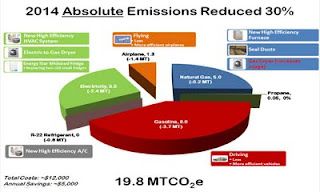Monday, December 19, 2011
Electric Hand Dryers
Summary:
$2,000 first cost, $17,200 annual savings, less than 2 month simple payback.
Existing Condition: Paper Towels in Restrooms
There are at least 9 restrooms in the building, all of which have paper towels for hand drying. Historic purchasing records show that 30 units are purchased per week at $15.42 per unit for an annual spend of $23,125.
Recommendation: Electric Hand Dryers
Remove the paper towel dispensers from restrooms and install energy efficient electric hand dryers. A good hand dryer will use 1,500 W or less and require about 12 seconds to dry the user’s hands. The Xlerator is one such option and sells for $400. It is recommended to install electric hand dryers in the two large production area restrooms. Since 90% of the building users are in the production and warehouse areas, these areas will see the greatest savings. Since the payback will be longer in the office area restrooms and the electric hand dryers can be loud, it is not recommended that hand dryers be used in these areas at this time. Most units do not require special wiring and can be installed with in-house labor. Units can be purchased online at sites such as: http://www.restroomdirect.com/high_speed_hand_dryers.aspx
Assumptions:
It is assumed that 2 hand dryers are needed per restroom for each of the two large restrooms. The units are $400 each. It is assumed that labor and mounting costs will be an additional $100 U.S. for each unit or $500 total. The total cost will be $2,000. It is assumed all 1,900 production and warehouse workers will use the restrooms and the hand dryers 3 times per day for 250 days per year. The units will draw 1.5 kW and will run for 12 seconds per use (0.0033 hours) for a total annual electricity consumption of 7,125 kWh. At $0.12 per kWh, this is $855 per year. It is assumed that 75% of the total annual paper towel cost is attributed to the two large restrooms, which represents $18,038 annually.
Notes:
This measure was identified for a factory in Tijuana. All prices were converted from Pesos.
Thursday, May 19, 2011
Residential GHG Reduction Plan
 ation of the night from the local students was by Steve O'Flarity, who drove up from Connecticut. Steve set a goal of reducing his household GHG emissions for his 3,000 square foot home by 30% by 2014 from a 2010 baseline. He calculated his family of 4 emitted 28 metric tons of carbon dioxide equivalent in 2010, including most Scope 1 and Scope 2 emissions and the Scope 3 emissions from air travel. He identified a number of GHG mitigation opportunities for his household including driving less, replacing their furnace, and switching from an electric clothes dryer to a new gas dryer (adding to his Scope 1 emissions but reducing his overall emissions). Great job Steve and thanks for letting me share your presentation, though I'll have to wait to attach the file until I can access my FTP site from my home computer.
ation of the night from the local students was by Steve O'Flarity, who drove up from Connecticut. Steve set a goal of reducing his household GHG emissions for his 3,000 square foot home by 30% by 2014 from a 2010 baseline. He calculated his family of 4 emitted 28 metric tons of carbon dioxide equivalent in 2010, including most Scope 1 and Scope 2 emissions and the Scope 3 emissions from air travel. He identified a number of GHG mitigation opportunities for his household including driving less, replacing their furnace, and switching from an electric clothes dryer to a new gas dryer (adding to his Scope 1 emissions but reducing his overall emissions). Great job Steve and thanks for letting me share your presentation, though I'll have to wait to attach the file until I can access my FTP site from my home computer.
Greenhouse Gas Planning Interviews
The class I co-teach at the Harvard Extension School, ENVR 116: Getting to Carbon Neutrality, just ended and as an extra credit assignment I had students interview professionals about their lessons learned in greenhouse gas planning. The details of the assignment are below. A number of the student interviews were really good and I learned a lot watching them. The first one I watched was Ian Hayes' phone interview (with still image) of Christoph Fuellemann, Environmental Delegate of Swiss International Airlines. He shares a lot of great experience related to trying to quantify and reduce emissions associated with the airline industry, including the contradiction between passengers wanting more space / leg room (fewer passengers per flight) and the desire to reduce emissions per passenger (more passengers per flight). According to Ian:
Mr. Fuellemann shares lessons learned from his experience at Swiss International Airlines, including how environmental advocates can be successful by pursuing opportunities that provide parallel financial and environmental benefits and be willing to make compromises with marketing to balance passenger service goals with emissions reduction targets.

All the interviews can be found here: http://vimeo.com/groups/envr116
ENVR 116 Extra Credit Assignment
Overview: Conduct, record, and summarize a short interview with somebody who has or may have in the future responsibility for developing a portion of a Climate Action Plan for an organization.
Purpose: Collect and share current best practices and lessons learned in developing Climate Action Plans, allowing others outside of the class as well as future classes to have access to this information.
Requirements: The interview must start with an introduction of the interviewee and a succinct description of their experience or familiarity with Climate Action Planning. The interview needs to include a description of a specific lesson learned or best practice in the field based on the experience of the interviewee. The idea is to identify any potential difficulties in the GHG planning process and hopefully some ways to overcome these difficulties and / or to share success stories of GHG planning processes that were successful. You may want to focus on issues with data collection, funding, staffing, reporting, stakeholder engagement, or any of the other pieces of a GHG reduction plan. Total time of the interview should be between three and five minutes.
Sunday, February 27, 2011
Green Building Benefits
Hello Nate,I hope all is well. I just had a class last night and one of the students is interested in doing a research paper on green building. I recall that this is your specialty - is that right? She is a bit lost and I can't help much with that subject. I was wondering if you could recommend any good books, or ideally, any good journal articles which discuss the economics of green building - ie. cost benefits analysis/ long term benefits. Anything you could suggest would be appreciated.
RESPONSE:
No problem. There aren't nearly as many resources on the cost effectiveness as I'd like to see, but I'll share what I know. The USGBC tries to collect all of this and has a list under "Research Publications" Here's the link: http://www.usgbc.org/DisplayPage.aspx?CMSPageID=77
One of the sub-headings is "Cost Analysis of Whole Buildings". The 2009 Kats and the 2007 paper by Langdon are probably your best bets for general cost / benefits studies.
As for the value of green buildings, CoStar Advisor has put out some reports: http://www.costar.com/josre/doesGreenPayOff.htm
I think the New Buildings Institute has one as well, but I didn't find it in my quick search.
Here's one on the benefits of increased productivity: http://www.costar.com/uploadedFiles/JOSRE/JournalPdfs/04-Green-Buildings-Productivity.pdf
Here's another good one on financial benefits / feasibility of green buildings (globally focused): http://www.wbcsd.org/Plugins/DocSearch/details.asp?DocTypeId=25&ObjectId=MzQyMDQ
This should get your student started. The USGBC site has lots of papers, but I should warn you that they're a mix of quality, with very few being from peer reviewed journals. If she refines the research question a bit more (what component of green buildngs? energy efficiency? re-sale value? increased occupant comfort? reduced risk of cancer? which type of green building? commercial offices? schools? homes? etc.) feel free to contact me for additional info. Not really any good books on the benefits, but some decent ones on how to design / build a green building if she does a search on the subject.
Nathan
Thursday, February 17, 2011
Selecting Low-Maintenance Plants
Are you aware of a recognized standard that identifies "low-maintenance/indigenous" plantings for sustainable landscaping in different geographies?
Response:
I don’t know of any guide that identifies native / adapted vegetation (low-maintenance) for the entire US and was always at a loss when asked by a design team. Plant selection changes a lot based on region and even local microclimate. For the most part, anything local is always a safe bet. For adapted plants, you want something that doesn’t require much water, fertilizer, or maintenance and won’t get out of control. The general rule is also to avoid turf grass as much as possible and use lots of mulch. If you are putting the landscaping out to bid, you could include a performance requirement that says plants must be native to the area or require minimal maintenance, etc. The attached documents might help you define xeriscaping or a process each site should employ when selecting plants. For example, you could emphasize the 7 principles found here: http://www.energysavers.gov/your_home/landscaping/index.cfm/mytopic=11960
This site is supposed to let you select water efficient plants, but I can’t get it to work: http://www.h2ouse.org/gardensoft/index.aspx
There are a few good sites for specific regions. For example:
Missouri: http://extension.missouri.edu/explorepdf/agguides/hort/g06912.pdf
Austin, TX: http://xeriscape.sustainablesources.com/
Colorado: http://www.ext.colostate.edu/pubs/garden/07228.html
You might also want to check out one of these books:
“Landscape Plants for Western Regions: An Illustrated Guide to Plants for Water Conservation” http://www.amazon.com/exec/obidos/ASIN/0960598839/phoenixtropicalg/002-2301829-6294425
“Waterwise Landscaping with Trees, Shrubs, and Vines: A Xeriscape Guide for the Rocky Mountain Region, California, and the Desert Southwest” http://www.amazon.com/exec/obidos/ASIN/096704510X/qid%3D1010441830/ref%3Dsr_11_0_1/002-2301829-6294425
“Plants for Natural Gardens: Southwestern Native & Adaptive Trees, Shrubs, Wildflowers & Grasses” http://www.amazon.com/exec/obidos/tg/detail/-/089013281X/ref=pd_sim_b_4/002-3622213-9240020?%5Fencoding=UTF8&v=glance
A good landscaper should be able to help you define this for your site (as should a good nursery):
Association of Professional Landscape Designers: http://www.apld.com/
American Society of Landscape Architects: http://online.asla.org/scriptcontent/index_find_firm.cfm
I hope this helps and good luck,
Nathan


